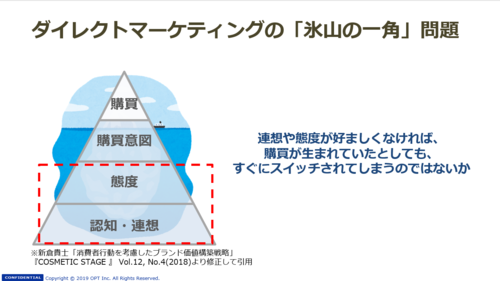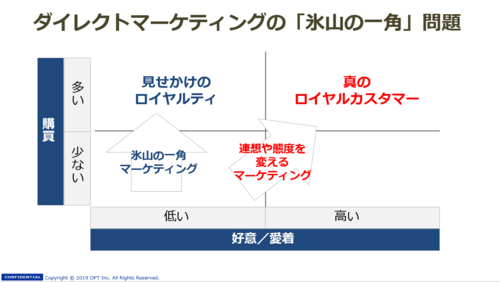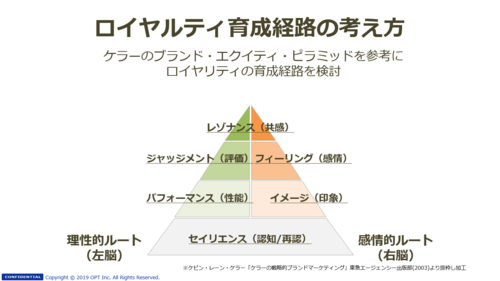
On May 25th (Saturday), 2019, Director Takeyoshi Sonobe of the Marketing Management Department released a society report together with Professor Takashi Niikura of Hosei University and Associate Professor Osamu Hotta of Nazan University based on the theme of “Towards Understanding Indices for Building Brand Loyalty,” at the “Japan Society of Marketing and Distribution’s 69th Nationwide Study Group” held at Doshisha University.
This report describes examples of planning CRM and designing the PDCA cycle based on the theory of building brand loyalty advocated by Professor Niikura, who is famous for having written “A Study of Consumer Behavior.”
An excerpt from this report is provided here.

■Two issues in traditional marketing techniques
As a marketing consultant, I often provide data-driven marketing support for the e-commerce/mail order industry, and I have noticed certain challenges.
Although the direct marketing industry has massive amounts of data available, it tends to focus too much on marketing aimed at motivating user actions, and does not spend quite enough time considering user psychology. I think that it is more important to “build a happy relationship” than to simply focus on “making a user buy.” To meet this challenge, I utilize Professor Niikura’s consumer action model. First I would like to describe two of the challenges I felt, followed by examples.
■The “Tip of the Iceberg Problem”
A wealth of data is accessible to the e-commerce/mail order industry, and since is it an industry for which user actions are easily visible, marketing is extremely advanced, as it is possible to “capture buying intent that is the tip of the iceberg in order to cause users to make purchases.”
At the same time, little information is available regarding the user’s “attitudes” and “associations” hidden underneath the surface.
If these attitudes and associations are not positive, there is the risk of a repeat customer switching to another brand.
In other words, there is a risk of creating “superficial loyalty.”


■Changes in marketing activities
Marketers used to enjoy even greater influence before the rise of the Internet. People believed commercials and mass advertising, and made their purchases based on these beliefs.
However, since it is easy to acquire information now on the Internet, product reviews, social networks, and other word of mouth information greatly influences consumer actions.
In this type of environment, I think marketers have two basic options.
The first is to boost purchasing. As described above, this is “tip of the iceberg” marketing.
The second is to create customer experiences. By providing users with good experiences with a brand, the marketer can indirectly create positive word of mouth in reviews and on social networks, thereby exerting a positive influence on the purchasing behavior of users considering what to buy.
■Example (1)
This example describes the experience of a certain mail order company.
This corporation introduced marketing automation in order to predict buying intention from previous purchases, site visits, and other actions, and successfully increased sales.
And yet, when it measured the attitude of users regarding the brand with a questionnaire, it discovered that even heavy users did not necessarily have a favorable opinion of the brand.
In other words, the users were ready to switch brands as soon as a similar service was made available elsewhere.
The corporation then worked to develop a message based on an analysis of questionnaire results to see what the user felt, and what the user would need to feel in order to hold a favorable opinion regarding the brand and service.
The results of these efforts were somewhat successful, and users with a favorable opinion increased 20% after distribution of the message. However, although the favorability did increase, it took three months to verify results after the first survey, and so challenges remained regarding the speediness of the PDCA cycle.
■Example (2)
Now I will introduce the second example.
This company made “efforts to provide customer experiences by creating contact points with customers,” and proved that these good experiences increased the purchasing amounts of customers.
However, challenges remained as user “attitudes” remained numerically poor, and it was extremely difficult to move through the PDCA cycle in a short span of time.
Therefore, while designing “what to convey,” the company also started a project to resolve the challenge of “how to evaluate transformations in attitude.” This project broadly consisted of the following three items:
(1) User clustering through purchasing action analysis and questionnaire surveys
(2) Communication design for each cluster
(3) Construction of qualitative evaluation techniques for attitude transformations
The clustering in (1) was based on question items related to lifestyle in a questionnaire survey given to users of the corporation’s brand. Furthermore, the project organized the attributes of each cluster such as purchasing actions, site actions, brand associations, and net promoter scores (NPS) in order to derive personas.
As a result, the corporation realized that it had many users of types that were different from what it had been envisioning, including even heavy users.
This revealed that users with a variety of different lifestyles were facing the brand in their own different ways.
In (2), the project considered routes of fostering loyalty from each cluster while keeping Keller's Customer-Based Brand Equity Pyramid in mind.
This made it evident that the routes by which loyalty can be fermented and goals both differ depending on the cluster.
The correct answer is not to attempt to make every user a “super loyal user.” It is important to design optimal ways of interacting with the brand for each individual lifestyle.

In (3), the project analyzed data for actions highly correlated with attitude transformations, and developed indices for quantitatively evaluating attitude transformations.
■Challenges looking forward
Future challenges include understanding and developing the indices that correspond with each configuration layer of brand loyalty as well as integrated indices.
In particular, the development of mechanisms to evaluate transformations in associations and attitudes from quantitative data is important (purchasing actions, Web actions,word of mouth, and so on).
It is only when the overall picture of “brand loyalty as one single unit” behind each index is presented that marketing PDCA activities involving everyone from management to the factory floor become possible.

From left: Director Takeyoshi Sonobe of the Japan Society of Marketing and Distribution’s Marketing Management Department, Professor Takashi Niikura of Hosei University